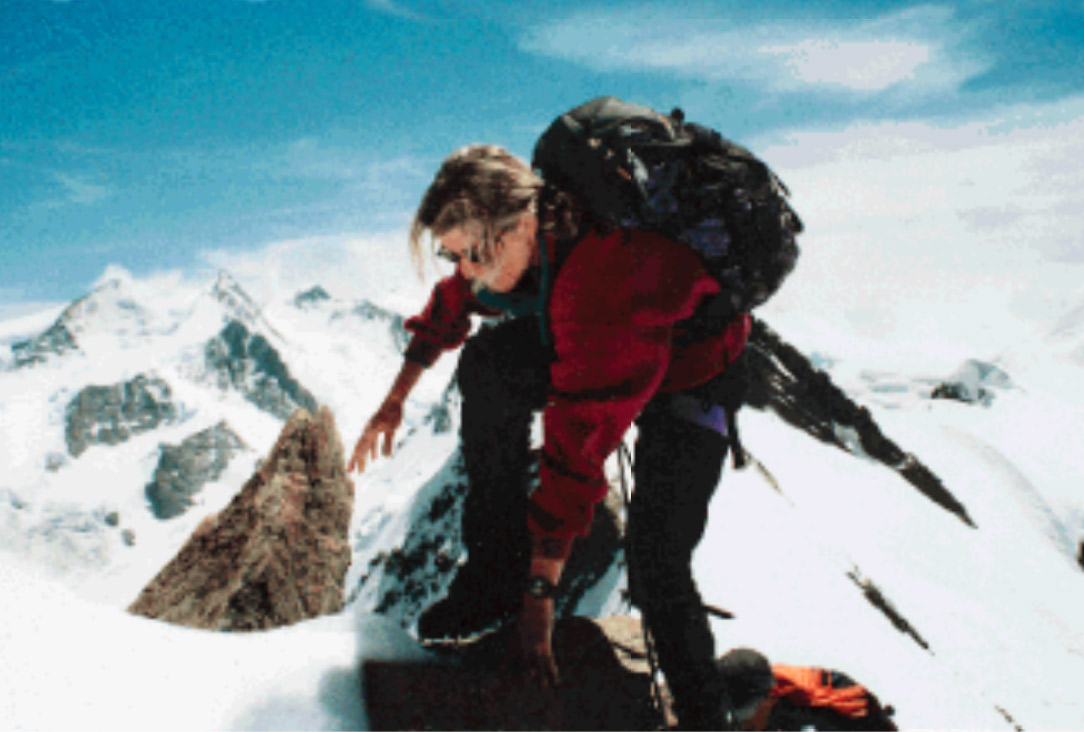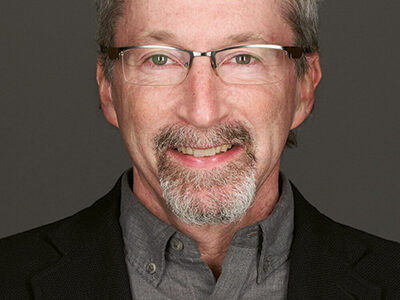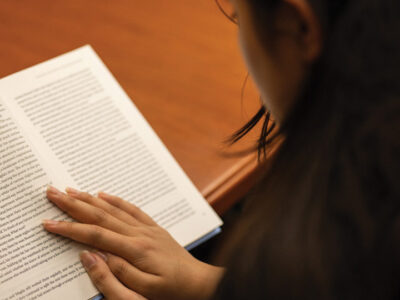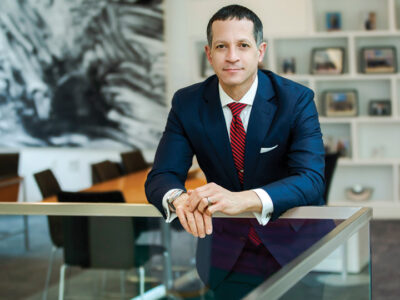
A professor of education and “middle-aged woman mountain climber” reflects on some lessons common to summiting and scholarship.
By Ursula Wagener | Photograph by Urs Lerjen
On the walls of my office at Penn’s Graduate School of Education I have hung color photographs of myself mountain climbing. Here in West Philadelphia, as we talk about higher-education issues, I sometimes wonder what my students think about their middle-aged woman professor’s “other life.” And I reflect on how my mountain-climbing experiences can help them with their ideas, aspirations, and careers. What ties my life as a teacher and climber together?
I have always been a hiker. I didn’t play soccer, tennis, or basketball as a child, but I could walk all day from the time I was five. I came late to climbing, however, which is a source of deep regret to me. The turning point occurred in 1990 when my husband, Marvin Lazerson, read about a middle-aged man climbing the Matterhorn and determined to try it himself. (At the time, Marvin, now the Carruth Family Professor of Education, was dean of Penn’s Graduate School of Education, and I think he believed that nothing was more difficult than university administration.) I had been to Zermatt in the 1950s as a young girl and had resisted returning as an adult, fearing that, like so much of Switzerland, the bucolic environment I remembered and saw in my parents’ old photographs had become high-rise hotels and ski lifts criss-crossing the valley like Los Angeles freeways. Zermatt is not like Los Angeles. We have returned every July since 1990, living at the Hotel Bijou, in the shadow of the Matterhorn, away from the hordes of tourists who come for 24 hours to take their pictures, ride the cog railway, and buy postcards. Marvin never has climbed the Matterhorn, but I did in 1992. Since then, climbing has become my life’s passion. I have stood on 18,000-foot mountains in Bolivia and Mexico; climbed the three peaks of Mt. Blanc, Europe’s highest mountain; scaled the Jungfrau in Switzerland; been to Mt. Rainier and summited Mt. Washington in the harshest mid-winter conditions. But most of all, I have lived and climbed in Zermatt, summiting more than 20 of the world’s most beautiful mountains over 4,000 meters.
1992: The Matterhorn; or, the Race to the Top
To understand my climb up the Matterhorn, you have to know two things. First, the climb has become Switzerland’s version of the New York Marathon. On many summer days, there are more people on the mountain than can fit and the race to get ahead of the crowd is intense. Second, my guide, Andre Lerjen, is a descendant of many generations of professionally trained and certified mountain guides. His father, Alfons, the story goes, once climbed the Matterhorn and returned in three hours. (The normal climb is eight to nine hours.) Before Andre went up with me, he asked if I thought I could make it to the top in four hours, since he did not climb with people who took longer.
Andre lives up to his family reputation. At 4:00 a.m., we are among the first out the door of the Hörnlihütte at the base of the mountain. I kiss Marvin goodbye. He is both excited for me and envious, but promises to remain at the hut until I return. Andre leads, holding the rope that is my security blanket as we head straight up over the rocks, following the glow of the few headlamps ahead of us. The going is hard, and Andre is passing whatever rope parties he can. The first time I look at anything but his feet, it is 6:00 a.m. and the sun has risen. We are halfway there; the Solvay hut, an emergency hut at 3,800 meters, is just above us. I am panting, my Philadelphia-acclimated lungs struggling in the thin atmosphere, and looking forward to leaving unnecessary gear at the hut. But Andre doesn’t even break stride as we pass the hut. I am afraid to say anything because rumor has it that the guides use this as a turning-around point for clients who don’t cut the mustard. Just above us is the shoulder of the Matterhorn, the snow and ice fields we must cross to reach the summit.
By the time we get to the summit, which is like a steeply sloping roof, I am tired, cold, barely able to see the beauty around me. As we perch on top, I am clutching Andre’s knee in the hope that this will keep me from a 1,200 meter slide back down to the Hoernli hut. Beneath my weariness, I am incredibly proud of making it, but Andre is already worried about getting caught in the traffic going down. “Do we have to catch a train?” I think. Descending is grim. On the first part of the roof, I hesitate, but Andre yells, “Das halt! Das halt!” (It holds! It holds! — referring to my crampons.) When we reach the fixed ropes just below the roof, a mass of what looks like 100 people is coming up. I want to wait, but Andre yells again, “Nicht warten!” (Don’t stop!) and I barely avoid digging my crampons into someone’s hand. There are several places where he lowers me down on the rope, trying to speed our descent, and yells at me, “Rauslehnen, rauslehnen! Weisst du nicht was das bedeutet?” (Lean out, lean out! Don’t you know what that means?) I realize that I am learning on the job, so to speak, and try to model his behavior or just do what I am told. Down, down, down. Not much room for the “creative thinking” I urge on my students. My legs are exhausted Andre is now behind me, tightly holding the rope, yelling in German, “Left, right, don’t sit,” and warning other climbers coming up to move aside.
Almost unbelievably, we are down, the ascent and descent accomplished in eight hours, not bad for a novice climber. Andre is pleased. Only a few other climbers have arrived ahead of us. Of the three women on the Matterhorn that day, I am the only one to summit. Marvin is there, more obviously ecstatic than I, his jealousy lost in pride at my accomplishment. He has the energy to gush; I concentrate on my wobbly knees, praying that I won’t fall and disgrace myself.
I have learned a lot. While climbing, I resented Andre’s commands. Once down, I understand how shrewd and careful he was, guiding and challenging me at the same time, teaching without lecturing that climbing is a skill in which adherence to rules and appropriate techniques is critical. The Matterhorn has a lot of loose rock, which is particularly dangerous as the day warms and the snow melts. Andre was not punishing me by demanding a speedy descent, but looking out for our safety. By following him up and down the mountain, mimicking his behavior, I have been initiated into the ranks of climbers.
1998: Becoming a Team
Shortly after climbing the Matterhorn with me, Andre became a Hutenwirt (hut manager) and must now spend most of his time overseeing a 70-bed hut that is the starting point for numerous climbs. He turned me over to his older brother, Urs, who became my regular guide, companion, and friend. Over the next five years, we became a climbing team.
The special relationship between guide and climber is an old-fashioned concept, lost in today’s faddish rush to climb the highest or most famous summit on a continent and then quickly move on to yet another summit. Before climbing became the sport du jour, a climber would spend summers in a mountain area like Zermatt, establishing a relationship with a local guide, and climbing many mountains with him. As the mountains become more and more difficult, teamwork is essential.
My relationship with Urs harkens back to that older time. In 1994, while on an exhausting 12-hour traverse of several 4,000-meter peaks leading to the Monte Rosa, which at 4,634 meters is the highest mountain in Switzerland, I desperately wanted to quit. Urs rightly gauged that I was capable of more, fueled me with Isostar (the Swiss version of Gatorade), and I finished the climb. At other times, especially on rock faces, I think I will be paralyzed with fear, but Urs’s competence and belief in me ease my anxiety.
My “coming of age” as a climber occurs in 1998, when Urs’s 13-year-old son Michi joins us on the Breithorn traverse, a seven-hour climb — almost all at above 4,000 meters. It is Urs’s signal to me that after five years of climbing together, he trusts me with a member of his family. Michi has already summited the Matterhorn with his father and is highly skilled, but he is still young, and occasionally I step in to smooth the relationship between him and his father, as, for example, when I offer him my cap upon learning that he’s forgotten or lost his sunglasses — a not insignificant mistake at this altitude and brilliant sunshine, as Urs makes clear. My role is not dissimilar to one I play in the classroom, reinterpreting or refocusing a student’s comments or providing help to students in difficulty.
Ten days later, Urs and I undertake a two-day climb of the Dent Blanche (4,356 meters), a free-standing, slightly tilted gneiss pyramid to the right of the Matterhorn. In our classrooms, we often have to establish safe environments that allow our students to talk freely without fear of judgment or recrimination, classrooms where they are willing to take intellectual risks. Here on the mountain, I am inching my way down a 200-meter slope of 45 degrees, a snow, ice, and rock ridge that drops steeply to the Dent Blanche hut. If I were faced with this dangerous descent on my own, I would turn back. The fact that Urs is behind, holding me on a short rope, allows me to focus on the terrain, take a well-executed step, and continue on. The next day a climber without a guide slipped on this very ridge and fell to his death. I offer a silent prayer of thanks to Urs for safely guiding me over the terrain and helping me learn from the mountain.
The next day’s climb is endless: one gendarme (rock tower) after another, not technically difficult but strenuous. Finally, we reach the summit, a small rocky space. I sit with the hood of my wind jacket up, too tired to care about more than the obligatory summit photo before we descend. Almost 12 hours from our 4:30 a.m. start, we finish the climb. I try to keep my legs from visibly shaking. Exhaustion, numbness, dehydration, mental lassitude, painfully swollen knees — “This is my last climb,” I tell my good friend Alfred Paci, the Hotel Bijou’s owner. “I’m too old for this. I should quit while I’m ahead.” Alfred laughs and pours me another glass of champagne. A week later Urs tells me that the next client he took up the Dent Blanche only made it to the first gendarme, and my own ascent is transformed into a brilliant success. I tell my students success is rarely immediate. On the mountain, I learn the hard way.
My final climb, the Weisshorn (4,505 meters), was one I had long wanted to undertake. Urs had resisted my entreaties for years. The Zermatt guides hate the three-to-four-hour, 1,500-meter climb to the hut the evening before. With a reputation for being one of the most demanding 4,000-meter peaks, the Weisshorn stands as a magnificent pyramid that dominates the sky with three knife-edged ridges finely sculpting the horizon. After new snow falls, the entire mountain looks icy white, giving it its name.
At the Weisshorn hut (2,932 meters), the mountain looms before me. I am stunned. The Weisshorn looks very different than it does from below. I see the detail of the rock ridge, the towers and gendarmes, and suddenly the mountain seems more accessible. Tears come to my eyes as some inner, gut feeling tells me I will successfully climb this mountain.
Urs arrives at the hut later. Without him, the journey would be just a climb, a summit accomplished. I have come to trust him totally, respect his mountaineering skills, his strength, and his intuitive sense of danger and safety. The next morning we start out at 2:30 a.m. The first three hours are a tedium of drudgery and darkness. I feel nauseated. I tell Urs, but he laughs and says, “Es ist nur Faulheit” (You’re only being lazy). I sigh and keep moving. One of the trademarks of a good coach is the ability to diagnose whether a player is just suffering from a temporary loss of energy rather than more general exhaustion. Urs persists in believing that I can make all summits. As a result of his coaching, I have climbed all but one of the peaks I intended.
Except for the feeling of “Thank God I’ve made it,” the summit is a non-event. It is too small and cold to stay for long. Usually on the way down from a difficult climb, I focus on all the dangers and how far I have left to go. This time, I tell myself, “Focus on each step, and how each safe step will bring you closer to home.” I am in superb mental and physical shape, and I do some of my best climbing. I read Urs’s commands before he makes them. We move together rhythmically as a team, with me moving ahead, and Urs constantly coaching, “left,” “right,” “straight over the ridge.” The rock ridge slopes down gently. Our rhythm and the gentle slope allow my body to work smoothly and efficiently, establishing confidence and a feeling of airiness. It’s one of those magnificent and rare moments when everything comes together to create perfection — the cold, crisp air, the stunning views, the effortlessness of the climb. I’m climbing in the sky. My blood is pulsing strongly, adding to my feelings of aliveness. Tears come to my eyes at the sheer awesomeness of the moment. It’s wondrously joyful. For me this is the true summit, not the top, a product of many years of training, teamwork, and the trust Urs and I have developed.
My Penn colleague, Bob Zemsky, professor of education and director of the Institute for Research on Higher Education, likes to tell the story of a doctoral student who he realized was a mountain climber by the way she described her plans for a dissertation. She laid everything out carefully before she began the journey, prepared for each step, knew she had to take everything she needed, was determined to succeed, and was willing to change course should conditions warrant.
I teach my students that when they conduct their research, they need to know what they are doing and how they intend to get there. On the mountain, each step is critical in itself, the difference between continuing to climb and injury. But each step has to make it easier to accomplish the next three or four steps. Just getting to a difficult ledge is not enough if you have no place to go from there. I tell my students that, if they can find companions they trust and who will help them, the journey will be safer and more fulfilling. Above all, I hope they learn to engage the journey with passion and to appreciate the beauty of its uncertainty.
Ursula Wagener is an adjunct associate professor in the Graduate School of Education and a consultant on higher education.




